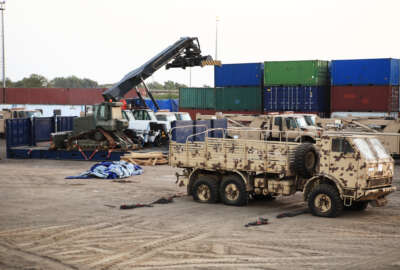How the Air Force manages risk in its supply chains
When a part is needed for a plane in the Air Force, it usually comes through the 448th Supply Chain Wing in the Air Force Sustainment Center. Ensuring that all ...
When a part is needed for a plane in the Air Force, it usually comes through the 448th Supply Chain Wing in the Air Force Sustainment Center.
Ensuring that all those parts get to their destinations, and that they are not tampered with or sabotaged, calls for a good deal of risk management.
Stephen Gray, director of the 448th Supply Chain Wing, says that risk management has been an ever changing and challenging problem as the United States tackles supply shortages, a pandemic and tries to lessen its reliance on Chinese goods.
“We’ve invested heavily in supply chain risk management capabilities, to where we can trace our supply chains down to the third, fourth or even fifth tier supplier,” Gray said on Federal Insights: Supply Chain. “We know where our parts are coming from. We are able to identify where we were going to see a risk. Now that could be a risk due to a weather event, a cyber attack, a financial problem within a supplier. We’ve even been able to map out those areas more to understand what type of disruptions could occur in our supply chain.”
Using that information, Gray said, the Air Force is able to prioritize high-risk suppliers and commodities. If the service needs to, it can develop a new supplier or continue working with one that is having issues. He tipped his hat to Congress for providing a stimulus package that allows the United States to do that.
While the Air Force has decent transparency into its supply chain and into its suppliers, there are still challenges it faces when it comes to delivering the goods and doing it on time and at a fair cost.
“We’re going to see inflation across the board as a result of the disruptions that we’re seeing in the pandemic,” Gray said. “Anything we do to reassure work will drive some inflation into the market, as well. The defense budget is closely scrutinized and there’s only so much we’re able to do to cope with large inflation. I think that’s one area that we’re very sensitive to and trying to watch.”
Gray said his office is working with companies on ways to keep the prices of goods from growing too out of hand.
Another issue is the continuing pains from the COVID-19 pandemic, which are still keeping goods at ports and causing long waits for some products.
“The next pandemic, or preparing for that, is really one of the things that’s on our mind as well,” Gray said. “How do we prepare ourselves, protect ourselves and be able to operate in either a continuant to the current pandemic or the next one that comes down the road. We just think from our businesses readiness perspective and being prepared for disruptions, that we need to keep our eye on the ball. We think the lessons learned that we found in the COVID-19 pandemic will serve us well for the next one.”
Copyright © 2024 Federal News Network. All rights reserved. This website is not intended for users located within the European Economic Area.
Scott Maucione is a defense reporter for Federal News Network and reports on human capital, workforce and the Defense Department at-large.
Follow @smaucioneWFED








